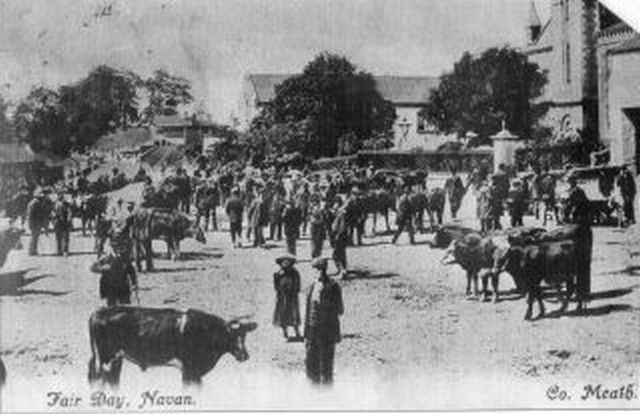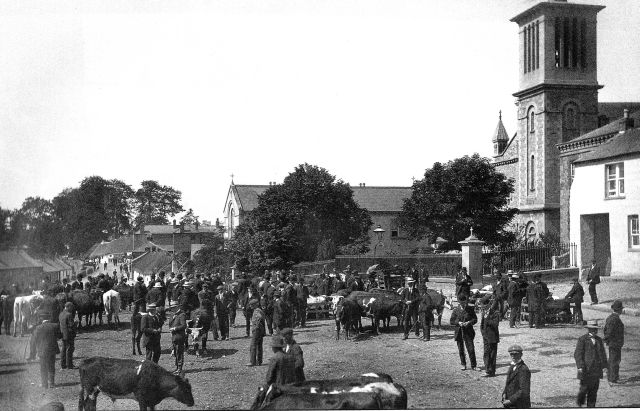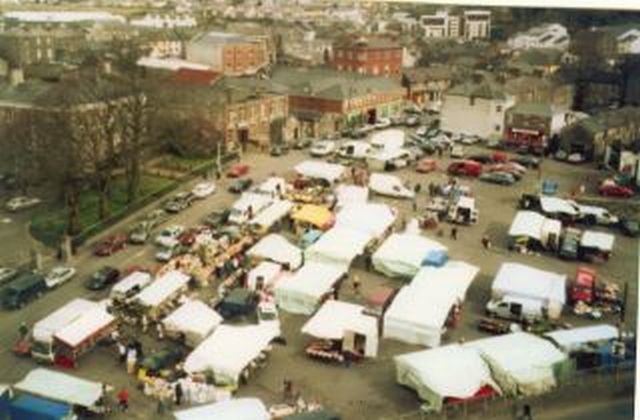Fair Green
Fair Green
It is easy to understand how the Fair Green got its name. It was originally a grassy commonage and in the mid 1800s the fair held here was called The Great Leinster Fair. It was considered one of the best monthly fairs in Ireland.
Farmers brought their livestock to sell and buyers came from England. The shopkeepers of Navan did good business on fair days. The pubs, eating houses, clothes shops, grocery shops and hardware shops were all busy.


Photo courtesy National Library of Ireland.
Cattle marts lead to the demise of fairs in the 1960s. The cattle mart was on the Carriage Road and closed in the 1970s. It is now the Telecom Eireann building.
*******
Newspaper reports give us a flavour of the old Fair's times:
The Times, 23 April 1870: Man threatened on his way to Navan Fair
A correspondent of the Daily Express states that on Monday as Mr. Gavin, of Kells, who holds some grasslands from Mr. Nicholson, of Balrath, was proceeding to Navan Fair on a car, which there were four men in all, he was stopped on the road by three men armed with revolvers, who made him go down on his knees on the road, while they warned him that, without any further notice, they would take his life if he continued to hold the land. This outrage, he says, has produced a panic among all classes in the county of Meath.
The Times, 2 March 1871
"........ Another case reported (at the Grand Jury in Trim) was that of Bryan Callaghan, the land baliff of the Earl of Fingall, who when returning from the fair of Navan was assaulted by three men, who met him on the road home. He was accompanied by four friends, but they rendered him no assistance. The reason assigned for this outrage is that “probably he was assaulted, as he had prosecuted a tenant for cutting turf.”
*******
The Fair Green is now car park and the site of a Friday market, pictured below, which is controlled by Navan Town Council.

Photo courtesy Bernard McCluskey
An ambitious plan to develop the Fair Green and the green area at St. Finians Terrace drawn up in the 2000s, met with opposition, followed by the economic downturn, and is unlikely to happen now.
Parochial House
A residence to house the priests of the Parish was built in 1845, on the right side of the church, facing the Fair Green, by Father Eugene O'Reilly.
Father O'Reilly began his time in Navan as curate in 1797. He was the founder and President of St. Finian's Academy in Academy Street and parish priest from 1827 to his death in 1852. He is one of the founders of the modern town of Navan.
*******
Navan Parochial House
The pre-famine years brought dramatic changes associated with industrialization and rapid increase in rural population.
Navan was a relatively prosperous urban centre in 1821 with important market and manufacturing functions. As a result, the town was attracting 'immigrants' without being able to provide the necessary employment and facilities. Its population in the period 1821-31 rose by more than 13% and almost half the workforce depended upon agriculture.
When potato blight struck in Germany, Belgium and Britain, these countries had guarded against starvation through buying supplies of cheap food as substitute for the potato. In total contrast the British Government neglected to do the same for Ireland and this country consequently was completely dependent on one crop, ie, the potato.
In 1845 the blight appeared first on the Wexford coast and then spread throughout the country. The failure of the Irish potato crop was almost total, resulting in hardship and starvation. The Catholic Church and associated organisations played an important role in alleviating the lot of the urban poor.
After centuries of oppression, the church was permitted to spread its gospel and hold services again. Due to this newly won freedom the number of church buildings increased and came to dominate the skyline. This could be clearly seen in Navan in the late 18th and early 19th centuries in the landscape, particularly in the location of church lands, and as church property.
The present parochial house in Navan, for example, built in 1845, is an accurate indicator of the Catholic Church’s 'rehabilitation' in society. The Meath Catholic people, despite their own hardship and suffering, gave willingly to the church the capital required to construct the building.
John Cantwell was Bishop of Meath at the time when Eugene O’Reilly built it in 1845. There were three priests in the parish and, in 1931, Rev. Patrick Mulvany extended the parochial house.
A new oratory was built into the house in 1973. The rooms on the ground floor, which previously had been bedrooms to facilitate students from St. Patrick’s Classical School, Navan, were converted to reception rooms for the public.
The funds required to construct this impressive building were given voluntarily even though it was at the height of the famine. It was a structure through which Meath Catholics could assert their own identity.